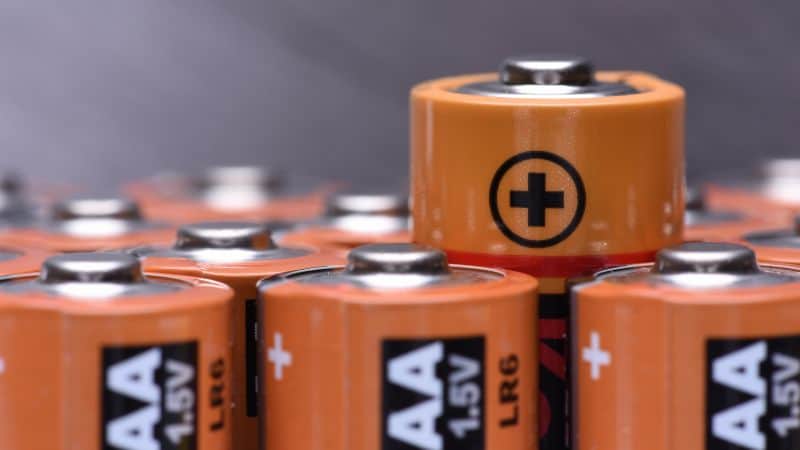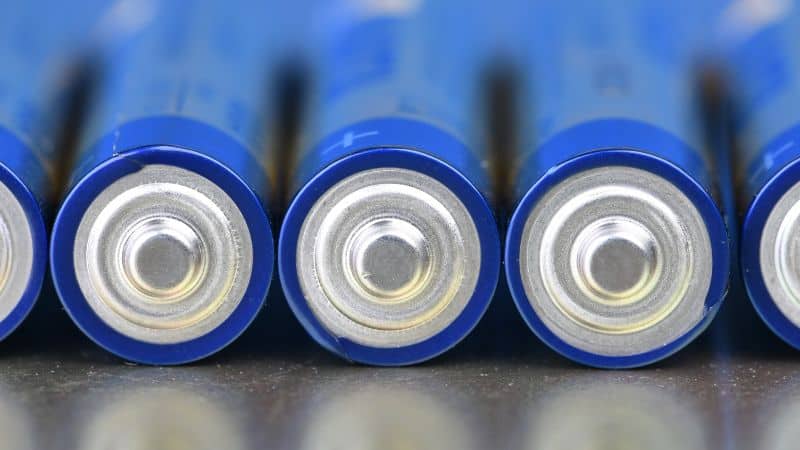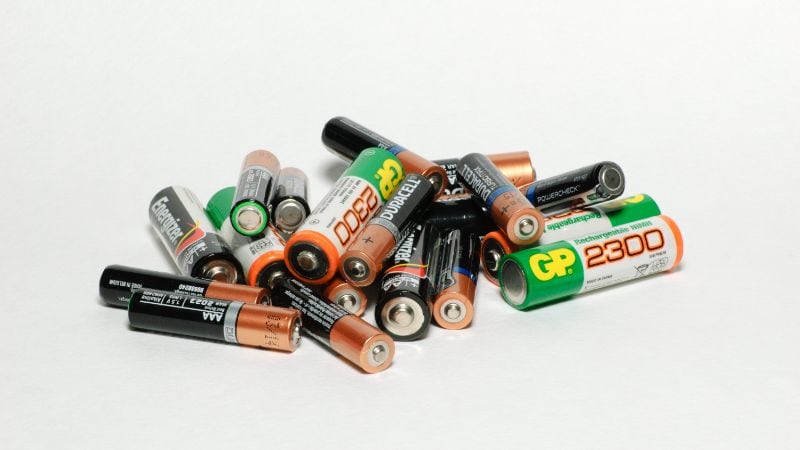AAA batteries are smaller in both size and capacity compared to AA batteries, with AAA measuring 10.5mm in diameter and 44.5mm in length, while AA batteries are 14.5mm in diameter and 50.5mm in length. This size difference affects which devices they can power and how long they’ll last.
The blog details the key differences between AA and AAA batteries, focusing on their size, capacity, common uses in various devices, performance, longevity, and environmental impact.

Difference between AA and AAA Batteries
Both AAA and AA batteries are common cylindrical alkaline batteries found in households worldwide, but they differ in several important ways.
Battery Size Differences
AAA and AA batteries are the most commonly used battery sizes in household electronics. AAA batteries are smaller than AA batteries in both length and diameter. While they share the same chemistry and voltage (typically 1.5 volts), their physical size makes them suitable for different applications.
AA batteries are often used in higher-power devices such as digital cameras, remote-controlled toys, and portable speakers. These devices require more energy over time.
AAA batteries are typically found in smaller, less power-hungry devices like TV remotes, small LED flashlights, and wireless keyboards. Their compact size makes them ideal for sleek, portable electronics.
Battery Capacity and Power
The primary difference between AAA and AA batteries is their capacity, measured in milliampere-hours (mAh). AA batteries generally have 2-3 times the capacity of AAA batteries.
Typical Capacity Comparison:
| Battery Type | Average Capacity |
| AA Battery | 1800-2800 mAh |
| AAA Battery | 800-1200 mAh |
This capacity difference means AA batteries can power devices longer before needing replacement. For high-drain devices like digital cameras or handheld gaming systems, this extended life is particularly valuable.
Despite their smaller capacity, AAA batteries deliver the same voltage as AA batteries. The difference lies in how long they can maintain that voltage under load.
Physical Dimensions and Compatibility
The specific dimensions of these batteries are standardized globally to ensure compatibility across devices and manufacturers.
Standard Dimensions:
- AA batteries: 14-14.5mm diameter, 50-50.5mm length
- AAA batteries: 10-10.5mm diameter, 44-44.5mm length
This size difference means they aren’t interchangeable without adapters. Some devices are designed specifically for one size based on power requirements and available space.
Battery adapters can convert AA batteries to fit AAA battery compartments, though this is a temporary solution. These adapters are simply sleeves that make up the size difference.
When choosing between these battery types, consider both the physical constraints of your device and its power requirements for optimal performance.

Common Uses for AAA and AA Batteries
AA and AAA batteries power a vast array of everyday devices in our homes, offices, and on the go.
Devices that Use AA Batteries
AA batteries excel in medium to high-drain devices that require substantial power. Digital cameras often use AA batteries because they need more energy for flash photography and LCD screens. Many portable audio players and Bluetooth speakers also utilize AA batteries for their longer-lasting power.
Wireless mice and keyboards commonly run on AA batteries, providing weeks or months of use before needing replacement. Remote controls for TVs, gaming consoles, and streaming devices frequently use AA batteries due to their balance of size and capacity.
Handheld GPS units and flashlights benefit from the higher capacity of AA batteries, especially in outdoor situations where recharging isn’t an option. Baby monitors and children’s toys often incorporate AA batteries for extended playtime and reliability.
Devices Commonly Using AAA Batteries
AAA batteries power smaller devices where space is at a premium. TV remote controls frequently use AAA batteries to maintain a slim profile while providing adequate power for occasional button presses.
Digital thermometers and other small medical devices typically run on AAA batteries due to their compact size. Wall clocks and small kitchen timers use AAA batteries that can last for months or even years.
Wireless headphones and earbuds often incorporate AAA batteries when designed to be lightweight and comfortable for extended wear. Small LED flashlights and headlamps use AAA batteries to remain compact while providing sufficient illumination.
Calculators and small electronic games commonly utilize AAA batteries to maintain portability. Laser pointers and presentation remotes also rely on AAA batteries for their combination of small size and adequate power delivery.
Performance and Longevity Comparison
Performance capabilities and longevity are critical factors that affect both value and user experience.
Battery Life in Everyday Devices
AAA batteries typically offer 800-1200 mAh capacity, while AA batteries provide 1800-2800 mAh – more than double in many cases. This capacity difference translates directly to runtime in devices.
In digital cameras, AA batteries might power approximately 300-400 shots, while AAA batteries would only manage 100-150 shots before needing replacement. This makes AA batteries the preferred choice for high-drain photography equipment.
Remote controls operate for significantly different durations depending on battery choice. A TV remote with AA batteries often lasts 8-12 months of regular use, while the same remote with AAA batteries might need replacement after just 3-6 months.
Flashlights show similar patterns. A standard LED flashlight with AA batteries can run continuously for 24-48 hours, whereas AAA-powered models typically last 8-18 hours under identical conditions.
Power Output Differences
AA batteries deliver more consistent voltage under load compared to their smaller counterparts. When powering high-drain devices, AA batteries maintain their voltage above usable levels for approximately 40-60% longer than AAAs.
In cold weather conditions, the performance gap widens further. AA batteries retain about 70% of their capacity at 32°F (0°C), while AAA batteries may drop to 50-60% capacity at the same temperature.
Peak current delivery also differs significantly between the two sizes. AA batteries can typically deliver 1-2 amperes in short bursts, making them suitable for motorized toys and power tools. AAA batteries generally max out at 0.5-0.75 amperes, limiting their effectiveness in high-current applications.
Power Stability Comparison:
| Battery Type | Initial Voltage | Voltage After 2 Hours (Heavy Use) | Voltage After 10 Hours (Heavy Use) |
| AA | 1.5V | 1.3-1.4V | 1.1-1.2V |
| AAA | 1.5V | 1.2-1.3V | 0.9-1.0V |
Types of AAA and AA Batteries
Both AAA and AA batteries come in various chemical compositions and designs to suit different devices and usage patterns.

Alkaline vs. Rechargeable Options
Alkaline batteries are the most common type for both AAA and AA sizes. These single-use batteries typically provide 1.5 volts and are ideal for low-drain devices like remote controls and wall clocks. They’re affordable upfront and have a shelf life of 5-10 years.
Rechargeable options include Nickel-Metal Hydride (NiMH) batteries, which deliver 1.2 volts and can be recharged hundreds of times. Though they have a higher initial cost, they become economical over time for frequently used devices.
10 Top Furniture Brands to Watch for Quality in 2025
Comparison of Alkaline vs. Rechargeable:
| Feature | Alkaline | Rechargeable NiMH |
| Initial Cost | Lower | Higher |
| Long-term Cost | Higher | Lower |
| Voltage | 1.5V | 1.2V |
| Self-discharge | Low | Medium to High |
| Best Uses | Low-drain devices | High-drain devices |
Pre-charged rechargeable batteries (like Eneloop) offer the convenience of being ready to use straight from the package.
Lithium and Other Specialty Batteries
Lithium batteries represent the premium tier in both AAA and AA formats. They last significantly longer than alkaline varieties and perform better in extreme temperatures. These batteries are ideal for high-drain devices like digital cameras and LED flashlights.
Lithium batteries typically weigh less than other types and have an impressive shelf life of up to 20 years. However, they come with a higher price tag.
Other specialty options include:
- Silver oxide batteries: Used primarily in watches and calculators
- Carbon-zinc batteries: Budget options with lower capacity
- Low self-discharge NiMH: Special rechargeable batteries that retain charge for months
High-capacity rechargeable batteries provide more power for devices like game controllers and wireless mice. Their capacity is measured in milliampere-hours (mAh), with higher numbers indicating longer run times between charges.
Environmental Impact
Both AAA and AA batteries have significant environmental implications when improperly disposed of. These small power sources contain materials that can be harmful to ecosystems if they end up in landfills.
Rechargeable versions of both battery types offer a more eco-friendly alternative to disposable options. A single rechargeable battery can replace hundreds of single-use batteries over its lifetime, substantially reducing waste.
Materials and Toxicity
- Both contain heavy metals like cadmium, lead, or mercury
- AA batteries have more materials due to larger size
- Improper disposal can lead to soil and water contamination
The larger size of AA batteries means they contain more raw materials, making their environmental footprint slightly larger than AAA batteries when comparing single units.
However, AAA batteries often need replacement more frequently in high-drain devices, potentially creating more waste over time. This can offset the initial material advantage they hold.
Recycling Rates
Proper recycling channels exist for both battery types, but consumer participation remains disappointingly low. Only about 10-15% of household batteries make it to recycling facilities.
Recent innovations in battery technology have reduced the toxic components in both sizes, making newer versions somewhat less environmentally harmful than their predecessors.
Energy efficiency is another consideration – some devices may run more efficiently with one battery size than the other, affecting long-term environmental impact through energy consumption patterns.
Selecting the Right Battery for Your Device
Selecting between AAA and AA batteries depends primarily on your device requirements. Most electronic devices specify which battery size they need, making this decision straightforward in many cases.
For devices that can use either size, consider the operating time needed. AA batteries typically offer 2-3 times more capacity than AAA batteries, making them better suited for high-drain devices like digital cameras and remote-controlled toys.
AAA batteries excel in compact devices where space and weight are concerns. Items like small remotes, headlamps, and slim electronic devices benefit from their smaller form factor.
Power Capacity Comparison:
| Battery Type | Typical Capacity | Best For |
| AA | 1800-2800 mAh | High-drain devices, longer runtime |
| AAA | 800-1200 mAh | Space-constrained devices, lightweight applications |
Weight can be another deciding factor. AAA batteries weigh approximately 11 grams, while AA batteries weigh around 23 grams, making AAA preferable for portable devices carried frequently.
Budget considerations might influence your choice too. AA batteries generally provide better value in terms of cost per unit of energy, though the initial purchase price is often slightly higher.
For emergency preparedness, keeping both sizes on hand is recommended. This ensures compatibility with various devices during power outages or other situations where battery power becomes essential.
Your Partner in Light: Trusted MF Opto for Innovation and Reliability
At M&F Optoelectronics, we take pride in offering innovative and reliable portable lighting solutions that are compatible with both AA and AAA battery technologies.
From rechargeable headlamps and rugged work lights to eco-friendly solar security systems, our product range is designed to meet diverse needs with uncompromising quality and efficiency. Our ability to provide customized, tailor-made solutions ensures that our lighting technology aligns perfectly with your objectives.
Explore our extensive product catalog here or contact us directly through our inquiry form. Discover how we’ve been trusted for over 15 years to deliver portable lighting excellence.






